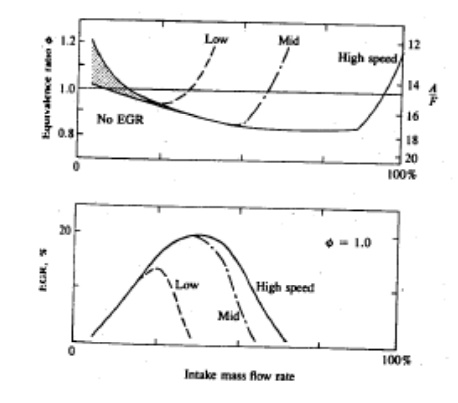Chapter: Mechanical : Advanced IC Engines : Spark Ignition Engines
Air-fuel ratio requirements
Air-fuel
ratio requirements
The task
of the engine induction and fuel systems is to prepare from ambient air and
fuel in the tank an air-fuel mixture that satisfies the requirements of the
engine over its entire operating regime. In principle, the optimum air/fuel
ratio for a spark-ignition engine is that which gives the required power output
with thelowest fuel consumption, consistent with smooth and reliable operation.
In practice, the constraints of emissions control may dictate a different
air/fuel ratio, and may also require the recycling of a fraction of the exhaust
gases (EGR) into the intake system. The relative proportions of fuel and air
that provide the lowest fuel consumption, smooth reliable operation, and
satisfy the emissions requirements, at the required power level, depend on
engine speed and load. Mixture requirements and preparation are usually
discussed in terms of the air/fuel ratio 0' fuel/air ratio and percent EGR. While the fuelmetering system is
designed to provide the appropriate fuel flow for the actual air flow at each
speed and load, the relative proportions of fuel and air can be stated more
generally in terms of the fuel/air equivalence ratio, which is the actual fuel/air ratio normalized by dividing by the
stoichiometric fuel/air ratio. The
combustion characteristics of fuel-air mixtures and the properties of
combustion products, which govern engine performance, efficiency, and
emissions, correlate best for a wide range of fuels relative to the
stoichiometric mixture proportions. Where appropriate, therefore, the
equivalence ratio will be used as
the defining parameter. A typical value for the stoichiometric air/fuel ratio
of gasoline is 14.6.t Thus, for
gasoline,

A brief
summary is sufficient here. Mixture requirements are different for full-load
(wide open throttle) and for part-load operation. At the former operating
condition, complete utilization of the inducted air to obtain maximum power for
a given displaced volume is the critical issue. Where less than the maximum
power at a given speed is required, efficient utilization of the fuel is the
critical issue. At wide-open throttle, maximum power for a given volumetric
efficiency is obtained with rich-of-stoichiometric mixtures, 4 X1.1. Mixtures
that are richer still are sometimes used to increase volumetric efficiency by
increasing the amount of charge cooling that accompanies fuel vaporization,
thereby increasing the inducted airdensity.At part-load (or part-throttle)
operating conditions, it is advantageous todilute the fuel-air mixture, either
with excess air or with recycled exhaust gas.This dilution improves the fuel
conversion efficiency for three reasons:' (1) theexpansion stroke work for a
given expansion ratio is increased as a result of thechange in thermodynamic
properties of the burned gases-see Sees. 5.5.3 and5.7.4; (2) for a given mean
effective pressure, the intake pressure increases withincreasing dilution, so
pumping work decreases; (3) the heat lossesto the walls are reduced because the
burned gas temperatures are lower. In theabsence of strict engine NO, emission
requirements, excess air is the obviousdiluent, and at part throttle engines
have traditionally operated lean. When tightcontrol of NO,, HC, and CO
emissions is required, operation of the engine witha stoichiometric mixture is
advantageous so that a three-way catalyst can beused to clean up the exhaust. The appropriate diluent is then
recycled exhaustgases which significantly reduces NO, emissions from the engine
itself. Theamount of diluent that the engine will tolerate at any given speed
and loaddepends on the details of the engine's combustion process. Increasing
excess air or the amount of recycled exhaust slows down the combustion process
and increases its variability from cycle to cycle. A certain minimum
combustionrepeatability or stability level is required to maintain smooth
engine operation.
Deterioration
in combustion stability therefore limits the amount of dilution ancan tolerate.
As load decreases, less dilution of thefresh mixture can betolerated because
the internal dilution of the mixture with residual gas increases. At idle
conditions, the fresh mixture will not usually tolerate anyEGR and may need to be stoichiometric or fuel-rich to obtain
adequate combustion stability.
If
stoichiometric operation and EGR are
not required for emissions control, as load increases the mixture is leaned out
from a fuel-rich or close-to-stoichiometric composition at very light load. As
wide-open throttle operation is approached a teach engine speed, the mixture is
steadily enriched to rich-of-stoichiometric the maximum point. With the
stoichiometric operating conditions required for three-way-catalyst-equipped
engines, when EGR is used, the
percentage of recycledexhaust increases from zero at light load to a maximum at
mid-load, and then decreases to zero as wide-open throttle conditions are
approached so maximum break can be obtained. Combinations of these strategies
are possible.
For example,
lean operation at light load can be used for best efficiency, and
Stoichiometric mixtures (with a three-way catalyst) and/or EGR can be used atmid loads to control NO, emissions.

Typical mixture requirements for two common
operating strategies: Top diagram shows equinlence ratio variation with intake
mass flow rate (percent of maximum flow at rated speed) at constant low and
high engine speeds. Bottom diagram shows recycled exhaust (EGR) schedule as a
function of intake flow rate, for low, mid, and high speeds for stoichiometric
operation.
In
practical spark-ignition engine induction systems, the fuel and air distribution between engine cylinders
is not uniform (and also varies in each individual cylinder on a cycle-by-cycle
basis). A spread of one or more air/fuel ratio between the leanest and richest
cylinders over the engine's load and speed range is not uncommon in engines
with conventional carburettors. The average mixturecomposition must be chosen
to avoid excessive combustion variability in theleanest operating cylinder.
Thus, as the spread in mixture nonuniformityincreases.The mean equivalence
ratio must be moved toward stoichiometric and away from the equivalence ratio
which gives minimum fuel consumption.
Related Topics